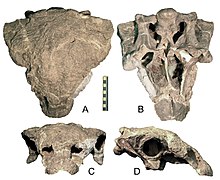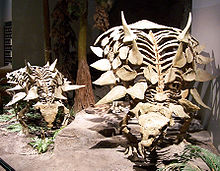Gastonia (dinosaur)
Gastonia is a genus of herbivorous ankylosaurian dinosaur from the Early Cretaceous of North America, around 139 to 134.6 million years ago.
[1][2] Gastonia is among the most common dinosaur fossils in the Cedar Mountain Formation, with many individuals being found across several quarries in the southwest.
[4] Gastonia was formally named and described by James Kirkland in 1998, from the holotype specimen and other fossil material recovered beginning in 1989.
[2] Gastonia burgei, was found in rocks of the Cedar Mountain Formation's Yellow Cat Member, which has been dated to the Valanginian, 139 to 134.6 million years ago.
[5] A second species, G. lorriemcwhinneyae, was described from the Ruby Ranch Member in 2016 based on a large bonebed that had been found by Lorrie McWhinney in 1999, probably formed when a group died of drought or drowning.
[1] The type specimen and its paratypes were collected by the Denver Museum of Nature and Science from Lorrie's Site in Grand County, Utah and belonged to the Ruby Ranch Member of the Cedar Mountain Formation.
[1] The type specimen is incomplete, consisting only of a skull roof, though many additional elements are paratypes from many portions of the skeleton.
This made Gastonia the first basal ankylosaurian dinosaur to have been mounted for display at the Denver Museum of Nature and Science, together with the related Gargoyleosaurus.
The tooth rows of the maxillae are rather straight and each consist of fifteen to sixteen small teeth, lacking a true cingulum, swollen basis.
More to behind, the bony tiles of the skull roof, the caputegulae, are rather indistinctively patterned though a small central plate on the parietal bones is visible.
Usually in ankylosaurs these have the form of "halfrings" leaving the underside unprotected, but with Gastonia only two segments seem present, one at each side of the midline, causing Kirkland to refer to them as "quarter rings".
Kirkland assumed that four pairs of triangular spikes covered the sides of the pelvic shield also,[2] but this was denied by Paul.
[8] The area between all these larger elements was covered by small ossicles, round bony scutes with a diameter of up to two centimetres, hundreds of which have been discovered.
[10][11] Sauroplites Mymoorapelta Dongyangopelta Gastonia Gargoyleosaurus Hoplitosaurus Polacanthus Peloroplites Taohelong Sauropelta Acantholipan Nodosaurus Niobrarasaurus Ahshislepelta Tatankacephalus Silvisaurus
[8] Other dinosaurs of the Yellow Cat include the ornithopods Hippodraco and Cedrorestes, the sauropods Cedarosaurus and Moabosaurus, and the theropods Martharaptor, Nedcolbertia, and Utahraptor.
Kirkland proposed that the typical ankylosaurid down-turned head, made possible by a more ventrally directed occipital condyle compared to nodosaurids, and an increased loosening of the rear skull elements to absorb shocks, were adaptations to this kind of behaviour.
[2] Ankylosaurs are often assumed to have been solitary living animals because their short legs seem poorly adapted to the trekking behaviour of herds, but the concentration of Gastonia fossils seems to contradict this.









